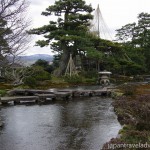 Kenrokuen Garden in Kanazawa is considered to be one of the three most beautiful gardens in Japan. The other two are Korakuen Garden in Okayama and Kairakuen Garden in Mito. The garden is conveniently located outside the gates of Kanazawa Castle. In its original form Kenrokuen Garden formed the outer garden of Kanazawa Castle. During the 17th century the garden was expanded and it reached its completion in the early 19th century. The garden was opened to the public in 1871, and covers over 25 acres of beautiful flowers, trees, ponds and waterfalls.
Kenrokuen Garden in Kanazawa is considered to be one of the three most beautiful gardens in Japan. The other two are Korakuen Garden in Okayama and Kairakuen Garden in Mito. The garden is conveniently located outside the gates of Kanazawa Castle. In its original form Kenrokuen Garden formed the outer garden of Kanazawa Castle. During the 17th century the garden was expanded and it reached its completion in the early 19th century. The garden was opened to the public in 1871, and covers over 25 acres of beautiful flowers, trees, ponds and waterfalls.
Design Principles of Kenrokuen Garden
The name kenrokuen translates as combined six, and refers to a renowned Chinese garden that required six attributes for perfection. These include seclusion, spaciousness, artificiality, antiquity, waterways and panoramas. You can find all these elements within Kenrokuen Garden, which make it the perfect garden.
Features of Kenrokuen Garden
Kasumigaike Pond
Located around the center of Kenrokuen Garden, it is the biggest pond in the garden and contains many of the must see features of the garden.

Kotoji toro Lantern
A stone lantern with two legs. It was designed in the image of a Japanese Koto (harp), and is a symbol of both Kenrokuen Garden and Kanazawa.

Uchihashi Teahouse
The teahouse as seen above is one of four in the garden. It is supported by stone legs and looks like its floating on Kasumigaike Pond.
Ganko Bashi (Flying Geese Bridge)
Made of eleven red stones that are laid out to resemble geese in a flying formation.

Sekirei-jima (Wagtail Island)
The name comes from Japanese myth. The island has a tori gate and three stones, which represent the three major ceremonies of life, birth, marriage and death.

Hanami Bashi (Flower Viewing Bridge)
The perfect place to view the seasonal flowers and hence the name. You can see plum and cherry blossoms in spring, azaleas and irises in early summer, green leaves in summer, beautiful autumn leaves in autumn, and white snow and yukitsuri (tree supports) in winter.

Kaiseki Pagoda and Midori-taki (Emerald Waterfall)
The Kaiseki Pagoda is a 4.1 meter high stone pagoda on a small island. In the background you can see the Midori-taki Waterfall; it is 6.6 meters high and 1.6 meters wide. It is visually as well as acoustically stunning.

Plum Grove Garden
The Plum Grove Garden contains around 200 plum trees of 20 varieties and is best in March, when the dark pink and white blossoms are at the peak.

History of Kenrokuen Garden
Kenrokuen Garden was developed from the 1620s to the 1840s by the Maeda clan, the ruling daimyo of the area (present day Ishikawa and Toyama Prefectures). The 5th lord Maeda Tsunanori moved his administration to Kanazawa Castle in 1676 and began to landscape a garden in the vicinity of the castle. The garden was destroyed by fire in 1759.
The restoration of the garden begun in 1774 by the 11th lord Harunaga, who created the Midori-taki (Emerald Waterfall) and Yugaotei Teahouse. Further improvements were made by subsequent lords, including the 12th lord Narinaga in 1822 and the 13th lord Nariysau. The garden’s current form was complete and it was opened to the public on May 7, 1871.
Opening Hours
Kenrokuen Garden is open from
7:00 am to 6:00 pm – 1 March to 15 October
8:00 am to 5:00 pm – 16 October to 28 February
Entry Fee
Adults: 300 yen
How to Get There
Take one of the Hokutetsu buses from Kanazawa Station (East Exit bus stop 3) to Kenrokuen and get off at Kenrokuen-shita bus stop. It takes around 15 minutes and costs 200 yen. Alternatively, take a JR bus from Kanazawa Station (East Exit bus stop 4) there are 2-3 buses per hour and they are covered by the Japan Rail Pass.
Address: Kenroku Machi, Kanazawa-shi, Ishikawa-ken 920-0936
Best Time to Go
Kenrokuen Garden is beautiful in all seasons. Spring is best for the plum and cherry blossoms, early summer for the azaleas and irises, summer for the green leaves, autumn for the beautiful red and yellow leaves, and winter for the snow covered landscape.
Tip: Visit the garden at 7 am and you should pretty much have the garden to yourself.











